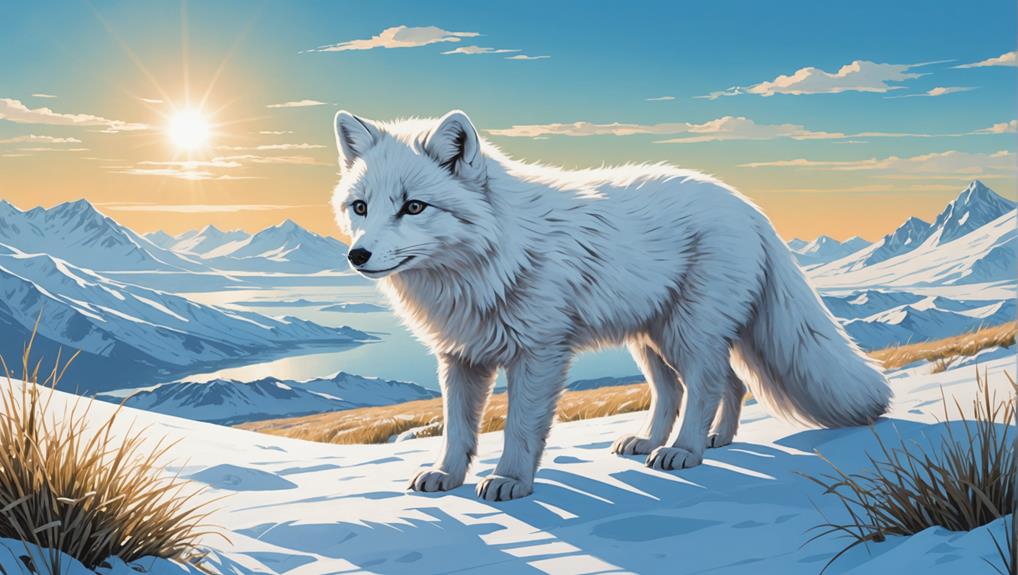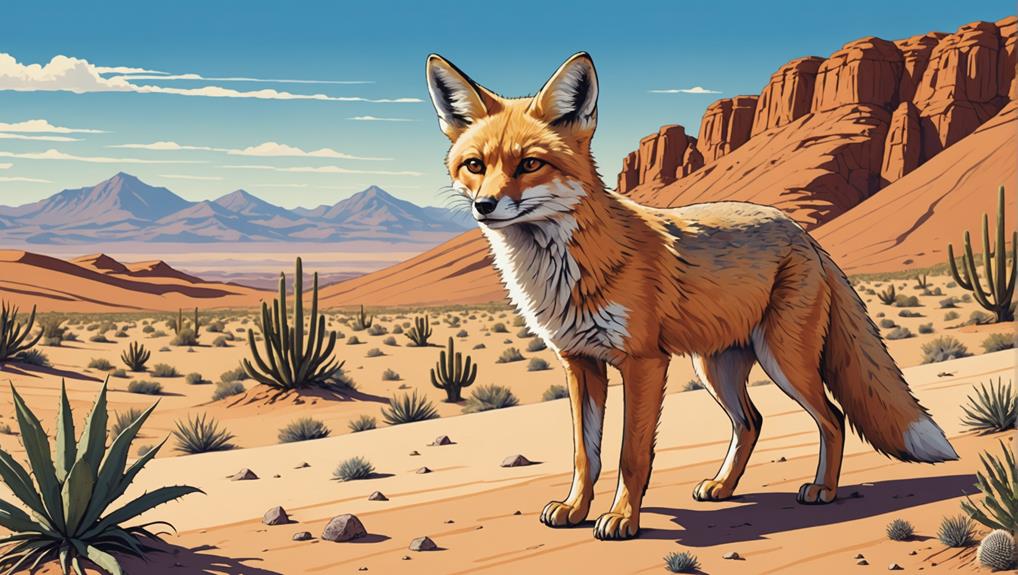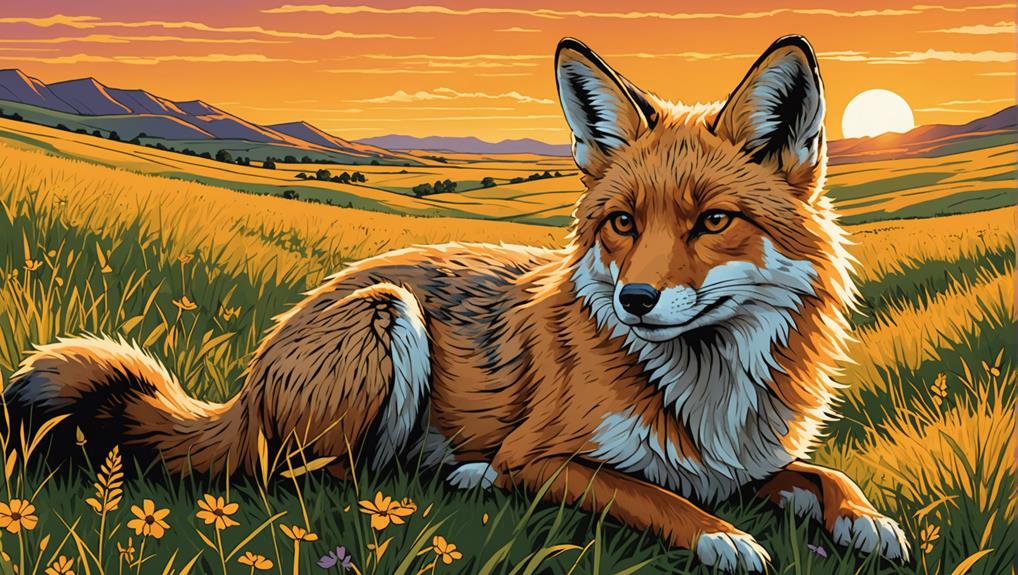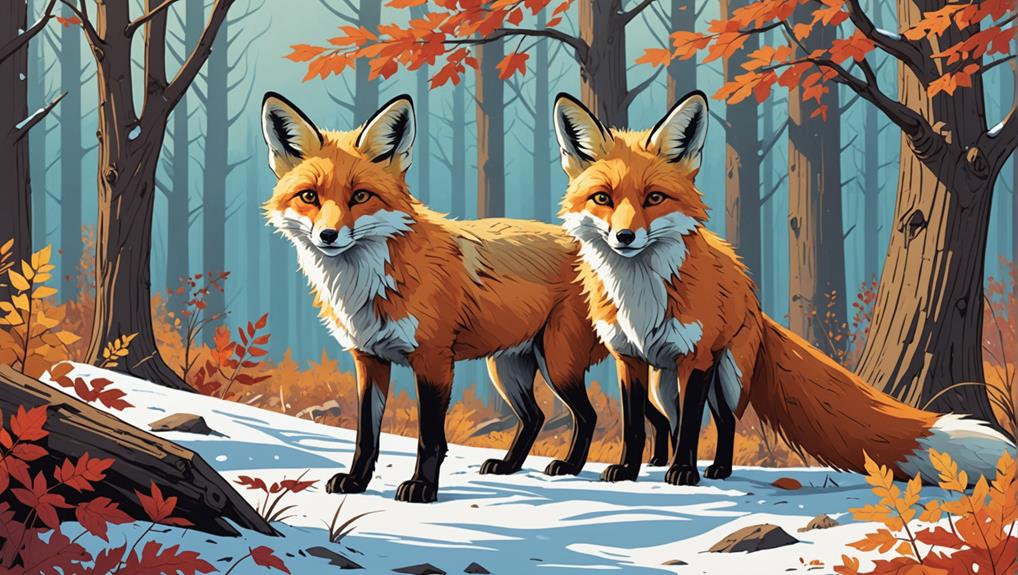If you're curious about the fascinating world of foxes, you've come to the right place! There are about 22 species globally, from the cheeky Fennec fox in the Sahara to the adaptable Red fox thriving in cities. Each type has its own unique habitat—some love forests, while others dig burrows in deserts. They're skilled survivors, whether climbing trees or caching food for winter. But let's not forget the challenges they face, like climate change and habitat loss. Stick around, and you'll uncover even more intriguing details about these crafty critters and their homes!
Contents
Overview of Fox Diversity
When exploring the fascinating world of fox diversity, you'll find that these adaptable creatures come in approximately 22 recognized species, showcasing a remarkable range of sizes and habitats.
From the majestic red foxes roaming North America to the tiny Fennec fox, weighing just over two pounds, every species has its own unique adaptations. They thrive in various habitats, from lush forests to bustling urban areas, proving they can make themselves at home just about anywhere!
However, not all foxes are thriving. Take the critically endangered Darwin's fox, for instance. With only around 639 individuals left, it highlights the urgent conservation needs many species face.
Protecting these amazing animals is essential not just for ecological balance, but also for preserving the cultural significance they hold in folklore across different regions.
Fox diversity is a testament to nature's creativity, reminding us of the importance of each species.
So, next time you hear a fox's call, remember that there's a whole world of foxes out there, each playing a role in the delicate tapestry of our ecosystems.
Let's work together to ensure these wonderful creatures continue to flourish!
Red Fox: The Adaptable Canid
The Red Fox is truly a remarkable creature, adapting to all sorts of habitats, from dense forests to bustling cities. Not only are they versatile in where they can live, but their social dynamics are just as fascinating, forming tight-knit family units that work together to thrive.
Habitat Versatility
Red foxes stand out as the most adaptable canids, successfully thriving in a variety of habitats across the globe. Whether they're darting through forests, prowling grasslands, or even strutting their stuff in urban areas, red foxes make it work!
Their remarkable habitat versatility allows them to scavenge human leftovers when times get tough, proving that adaptability is key.
These clever creatures prefer areas that offer a mix of cover and open space for hunting. They exhibit fascinating denning behavior too, using everything from underground burrows to abandoned buildings. Depending on what's available, red foxes can turn any place into a cozy home!
Their omnivorous nature plays a big role in their success, as they feast on small mammals, birds, insects, and fruits. This diverse diet allows them to thrive in various ecological niches and weather conditions.
Plus, their seasonal behaviors shift in response to changes in prey availability, which shows just how well they can adapt to their surroundings. So, whether it's summer or winter, red foxes are always on the move, proving that being flexible is a beautiful thing!
Social Behavior Dynamics
While observing red foxes in their natural habitats, you can't help but notice their intricate social behaviors. These clever creatures often form family groups, usually consisting of a mating pair and their kits.
It's heartwarming to see how older siblings pitch in to help raise the younger ones, creating a sense of community. Their social structure is quite fluid, allowing for unique interactions even when their territories overlap.
You might hear a variety of vocalizations—barks, screams, and even those cute little yips—each serving a purpose, from establishing territorial boundaries to strengthening bonds.
In urban populations, red foxes showcase remarkable adaptability, adjusting to human-altered environments and forming their own hierarchies. It's fascinating how they navigate the bustling city life, finding food and cozy dens while maintaining their playful nature.
During mating season, the dynamics shift, with females often leading social interactions. Males step up, providing support while they raise kits.
Arctic Fox: Life in the Frozen Tundra

How does the Arctic fox manage to survive in one of the harshest environments on Earth? This clever little creature, also known as *Vulpes lagopus*, is well-equipped for life in the frozen tundra.
With its thick fur and layers of fat, the Arctic fox thrives even when temperatures plummet. Its seasonal coat color change is nothing short of magical; in winter, it turns white for perfect camouflage against the snow, while in summer, it switches to a gray-brown to blend in with the tundra landscape.
As resourceful scavengers, Arctic foxes feast on small mammals like lemmings and birds. They even store food in caches, so they're prepared for those unexpected snack attacks!
You might find them in habitats across Greenland, Canada, and Russia, with prime viewing spots in Iceland and Svalbard.
Though their conservation status is currently classified as Least Concern, they face challenges from climate change, which threatens their habitats and food sources.
Fennec Fox: Surviving the Sahara
The Fennec fox, with its oversized ears and petite frame, is a remarkable survivor of the Sahara Desert. This small creature knows how to thrive in harsh conditions, and its distinctive adaptations make it truly fascinating.
Let's explore how the Fennec fox manages life in the desert:
- Camouflage: Its sandy coat blends perfectly into the surroundings, helping it hide from both predators and prey.
- Nocturnal Lifestyle: By being active at night, it avoids the extreme daytime heat, making it easier to find food.
- Family Groups: Living in small family groups, they provide support for raising young and foraging together.
Fennec foxes dig burrows up to 3 meters deep, where they escape the sun and create a cozy home for their kits.
Plus, they're not picky eaters! Their diet includes insects, small mammals, and fruits, showcasing their adaptability to the Sahara's scarce food sources.
These incredible creatures remind us of the importance of teamwork and resilience.
Kit Fox: The Desert Dweller

Although often overshadowed by their larger relatives, Kit foxes are remarkable desert dwellers that have adapted to thrive in harsh environments. Found in arid regions of the southwestern United States and northern Mexico, these nocturnal creatures are small yet agile, weighing between 1.5 to 2.6 kg. With their large ears, they're not just cute; those ears help dissipate heat and enhance their ability to hear their prey.
Here's a quick look at some key features of the Kit Fox:
| Feature | Description |
|---|---|
| Habitat | Deserts, scrublands, and grasslands |
| Diet | Mainly rodents, rabbits, and insects |
| Social Structure | Often found in family groups or pairs |
Kit foxes are known for their speed and agility, making them exceptional hunters and evaders of predators. They often dig dens into sandy soils, creating cozy homes that can be reused for generations. Who wouldn't want to raise their kits in a safe, warm spot? Watching these little foxes navigate their desert home can bring a smile to anyone's face, as they remind us of the beauty of adaptation and family in the animal kingdom.
Gray Fox: The Tree Climber
When you think of foxes, you might picture them darting through fields or sneaking around at night, but the gray fox is a real tree-climbing champion!
With special adaptations like semi-retractable claws and flexible ankles, this little guy can dash up a tree faster than you can say "squirrel!"
Let's explore their unique climbing skills, favorite habitats, and what tasty treats make up their diet.
Unique Climbing Adaptations
Among canids, gray foxes stand out for their remarkable tree-climbing abilities. You might wonder how they do it! Their secret lies in their semi-retractable claws, which help them grip the bark as they climb trees. This unique skill isn't just for show; it plays a vital role in their survival.
Here are three key benefits of their climbing prowess:
- Escaping Predators: When danger lurks below, gray foxes can quickly ascend trees, putting some distance between themselves and their foes.
- Accessing Food: Their varied diet includes fruits found in trees, supplementing their meals of small mammals. Who wouldn't want a snack that's just a hop and a climb away?
- Creating Denning Sites: By nesting in elevated spots, they enjoy safer havens for raising their young, away from ground-level threats.
The agility of gray foxes, weighing between 7-13 pounds, allows them to navigate the branches with grace.
Their climbing abilities not only benefit them individually but also contribute to ecological balance by keeping tree-dwelling rodent populations in check.
Habitat Preferences
In the heart of wooded areas and shrubby environments, gray foxes thrive by choosing habitats that offer both cover and open space. These clever creatures prefer to set up their homes in denning sites like hollow logs, rock crevices, or small burrows. By avoiding overly dense forests, they ensure they have room to roam and hunt effectively.
You might be surprised to learn that gray foxes are found across a wide geographical distribution, stretching from southern Canada to northern South America. Their habitat preferences truly reflect their unique lifestyle. They're especially active during dusk and exhibit nocturnal behavior, making them skilled hunters of small mammals and birds.
Here's a quick look at their habitat choices:
| Feature | Description | Importance |
|---|---|---|
| Cover | Shrubby environments | Safety from predators |
| Open Space | Wooded areas | Hunting grounds |
| Denning Sites | Hollow logs, rock crevices | Shelter for young foxes |
| Activity Pattern | Active during dusk, nocturnal behavior | Optimal hunting time |
Diet and Behavior
With their remarkable ability to climb trees, gray foxes stand out in the canid family. This unique skill, thanks to their semi-retractable claws, enhances their hunting prowess and adaptability. You may find these clever creatures thriving in various habitats, including both forests and urban areas, demonstrating their resourcefulness.
Their omnivorous diet includes:
- Small mammals
- Birds
- Fruits and insects
Gray foxes primarily hunt solitary, using stealth and agility to stalk and pounce on prey. They're like the ninjas of the animal world!
Plus, they sometimes cache food for later, ensuring they've enough to eat during lean times. Although they're mostly solitary, they can form family groups, revealing a complex social structure that adds depth to their lives.
In essence, gray foxes are adaptable survivors, expertly navigating both their forest habitats and urban landscapes. Their ability to climb trees not only helps them escape predators but also opens up a world of food sources.
Swift Fox: The Prairie Sentinel

The swift fox, a remarkable creature of the Great Plains, embodies the spirit of the prairie. This small, nocturnal fox is an agile little marvel, weighing only about 2.2 to 3 kg. With its slender body and large ears, it's built to thrive in open habitats, hunting small mammals and insects with impressive speed—up to 50 km/h! Imagine trying to catch a meal while running that fast!
Breeding occurs between January and March, and both parents share the responsibility of caring for their adorable pups. They usually have 2 to 6 little ones after a gestation period of about 50-60 days. It's heartwarming to see such parental care in action, isn't it?
Unfortunately, swift fox populations faced significant declines in the 20th century due to habitat loss and hunting.
But don't worry! Thanks to dedicated conservation efforts, including habitat restoration, these charming creatures are making a comeback. Every effort counts, and you can feel proud knowing that by supporting wildlife conservation, you're helping protect the swift fox and its prairie home.
Habitat Conservation and Future Challenges
Habitat conservation is vital for ensuring fox populations thrive amidst growing challenges. As urbanization continues to spread, it leaves many species, like the endangered Sierra Nevada Red fox and Darwin's fox, facing shrinking homes. Climate change complicates matters further by altering habitats and prey availability, especially for vulnerable foxes like the Arctic fox.
To tackle these challenges, we can focus on three key areas:
- Conservation Initiatives: Protecting and restoring habitats is essential for maintaining ecological balance. Every action counts!
- Public Education: Raising awareness about human-wildlife coexistence can reduce conflicts. Who knew that understanding your furry neighbors could help everyone live happily together?
- Support for Threatened Species: By prioritizing endangered fox species, we can work towards ensuring their survival for future generations.
Together, we can make a difference. By embracing conservation efforts and being mindful of our environment, we can help sustain the delicate balance between urban life and nature.
Let's get involved, spread the word, and support initiatives that promote habitat conservation. After all, a thriving fox population isn't just good for the foxes; it's good for us, too!
Final Thoughts
In conclusion, foxes are pretty amazing creatures, each with their own unique story and habitat. Whether they're darting through snowy tundras or lounging in the Sahara sun, these clever canids remind us how diverse our world is. But they face challenges that need our attention. By caring for their homes, we can help ensure future generations get to enjoy the charm of these fascinating animals. So, let's give a paw for our furry friends and protect their wild spaces!














